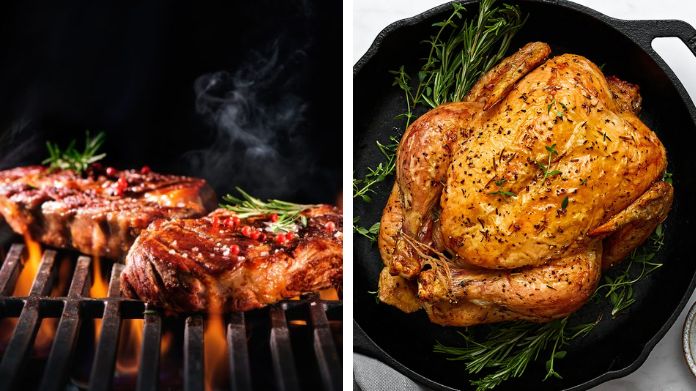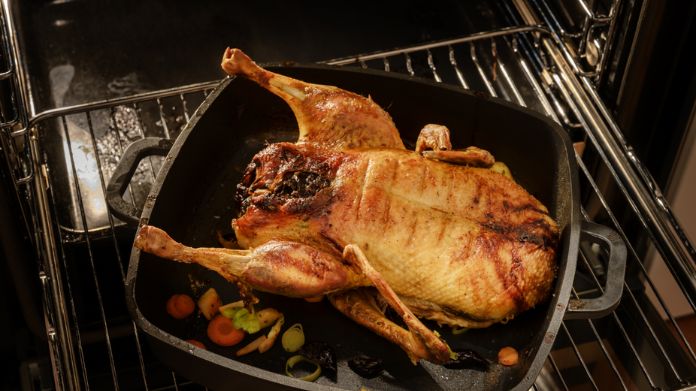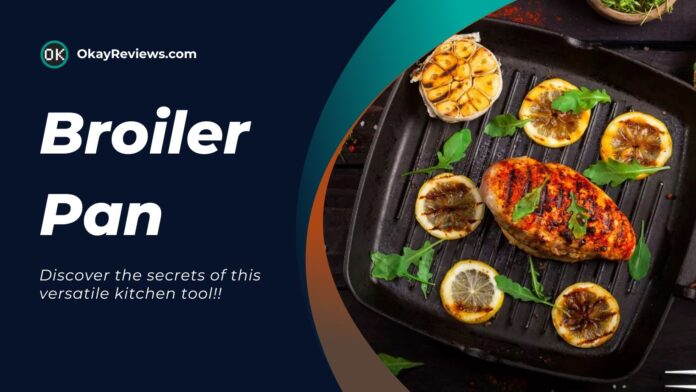Have you ever wondered about the broiler pan, a strange culinary tool? You may have noticed it hidden in your oven and need to figure out what it’s for.
You’re in for a treat today because we will reveal the secrets of the broiler pan and teach you how to utilize it to benefit you in your culinary adventures.
In this article, Okayreview unravels the secrets of the broiler pan, looking at what it is, what it does in the kitchen, and how to use it successfully.
There’s something here for everyone, whether you’re a seasoned cook or a kitchen novice.
Also, don’t throw the remaining pie crust crumbs! Make them into scrumptious Pie Crust Cookies that will melt in your mouth instead.
So, let’s dive in and discover the secrets of this versatile kitchen tool.
Table of Contents
Broiling vs Roasting: Cooking Methods
 Before we delve into the world of broiler pans, let’s clear up a common kitchen conundrum – the difference between broiling and roasting.
Before we delve into the world of broiler pans, let’s clear up a common kitchen conundrum – the difference between broiling and roasting.
Have you ever wondered when to broil and when to roast your food? Well, you’re not alone.
Broiling
Broiling is a high-heat procedure that uses the top oven element. It instantly sears and crisps things, leaving a caramelized coating on them.
Place the food on the top rack and keep an eye on it; broiling is quick at 500-550F.
Roasting
Roasting is a slow-cooking technique using dry, indirect heat to produce roast chicken, crispy potatoes, and delicate vegetables.
It’s comparable to high-temperature baking using all the oven’s heating components. Roasting increases flavors and develops browning at temperatures of 400F or higher.
Now that we’ve sorted that out, let’s dive into the world of broiler pans.
What Exactly is a Broiler Pan?
It, also known as a broiler roaster, plays an essential function in cooking by directly exposing food to intense heat.
Broiling, as opposed to roasting, uses a shallower, two-part design: the upper pan for food and the lower pan for collecting drippings.
With the heat source coming from the top of the oven, this approach distributes heat evenly and rapidly. However, caution is essential since food can cook quickly and require frequent flips.
It can withstand high heat, making it indispensable for broiling, roasting, and baking.
They may also be used as broiler pans on outdoor barbecues for more minor things. These specially designed pans outperform non-broiler cookware, ensuring safe and successful cooking at temperatures above 500°F.
A broiler pan is a must-have in your culinary arsenal for attaining those beautifully browned and crisped results, whether you’re new to broiling or need a replacement.
How to Use Your Broiler Pan: Step-by-Step Guide
 Using a broiler pan is surprisingly straightforward, but let’s break it down into easy-to-follow steps:
Using a broiler pan is surprisingly straightforward, but let’s break it down into easy-to-follow steps:
1. Locate Your Oven Broiler
It is simple to locate your oven broiler. It’s usually located towards the top of your oven, just below the hob burners.
These broilers produce heat and look like glowing tubes or strips when activated. They may be in a different drawer beneath the oven but function similarly in certain circumstances.
Find them in a separate compartment under the hob or at the bottom of the oven.
2. Position Your Oven Rack for Broiling
Positioning your oven rack for broiling is critical to guarantee optimal cooking. If your oven’s broiler is at the top, set the rack to the highest position, about 3 to 4 inches from the heating element.
It’s usually 4 to 5 inches distant for ovens with broilers in a drawer. Adjust for thick or dense items to avoid scorching the surface layer before cooking.
3. Turn on the Broiler
Allow 5 to 10 minutes for your broiler to heat up, depending on your oven.
Most ovens include a basic on/off broiler option; others require a temperature setting of roughly 500°F. To prevent overheating, leave the oven door slightly ajar.
4. Broil Your Food!
Place your meal on the oven rack and move it under the broiler to broil. Keep an eye on everything since broiling happens quickly.
Most meals cook in 10-12 minutes and can burn rapidly, so remove them as soon as they are done.
Broiling, unlike slow cooking methods, needs continuous monitoring to avoid overcooking or burning.
Effective Tips for Using Broiler Pan
Here are some hints and tips for using it:
- Always preheat your broiler: Broilers operate at high temperatures, so preheat them before adding food. It ensures that your food cooks properly and prevents undercooked meat or the formation of hazardous bacteria.
- Use appropriate heat: Because different broiler pans are constructed of other materials, choosing a temperature suitable for your pan is critical. A pure aluminum pan, for example, can sustain higher cooking temperatures than a ceramic pan.
- Evenly position your food: Before placing your meal under the broiler, ensure everything is evenly distributed in the pan. It ensures that your meal cooks evenly and avoids overdone outside meat from coming into contact with uncooked inside meat.
- Clean it immediately after use: Because Broiler pans are generally nonstick, cleaning them immediately is essential.
Following these hints and tips, you can broil like a chef and simplify your cooking in a broiler pan.
The Benefits of Using a Broiler Pan
You may be thinking about the benefits of utilizing a broiler pan now that you’ve mastered the technique of broiling:
- Healthier Cooking: It can help lower the total fat level of your foods by enabling excess fat to drain away from them.
- Crispy and Delicious: Perfect the sear and caramelization of your meats and veggies for exquisite flavor and texture.
- Easy Cleanup: Most broiler pans are simple to clean because of their design and materials.
- Versatile: It isn’t just for meats; they may also be used to broil vegetables and shellfish.
- Kitchen Essential: If you enjoy cooking but don’t have access to a broiler, an indoor grilling partner might be a broiler pan.
Frequently Asked Questions
Q. Can I Broil Frozen Food?
Ans. Broiling frozen food is generally not recommended as it can result in uneven cooking.
Q. How Do I Prevent Smoke While Broiling?
Ans. To reduce smoke, trim excess fat from your food, and consider lining the drip tray with aluminum foil for easier cleanup.
Q. Can I Broil in a Toaster Oven?
Ans. You can broil in a toaster oven, but it may have a smaller broiling area, so adjust your cooking times accordingly.
Q. Can I Use a Broiler Pan on the Stovetop?
Ans. Broiler pans are not suitable for stovetop use. They are designed for oven broiling only.
Takeaway!!
We hope you’ve learned something new about this kitchen necessity. Remember, the broiler pan is more than a convenient tool; it’s the key to sizzling steaks, flawlessly browned seafood, and delectable vegetables.
Get creative, try new flavors, and remember to tell your friends and family about your broiler pan exploits.
Happy cooking! 🍽️✨

